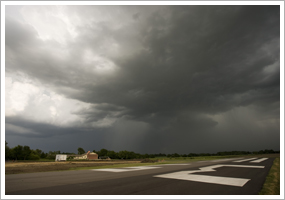This is the custom content for the August 6, 2010, issue of 'AOPA ePilot' e-newsletter.
| The following stories from the August 6, 2010, edition of AOPA ePilot were provided to AOPA members who expressed an interest in the particular subject areas. Any AOPA member can receive information tailored to their areas of interest by updating their preferences online. |
training tipsStorms ‘in the vicinity’ Brush up on weather-reporting terminology to help you decide on a plan of action. Barry Schiff probed pilots’ knowledge with this question in the December 2006 AOPA Pilot “ Test Pilot” column:
A pilot approaching an airport hears an automated weather report stating that there is a "thunderstorm in the vicinity" of that airport. This means that the cell is:
Which did you choose? The answer, and its published abbreviation, are found in Chapter 12 of the Pilot’s Handbook of Aeronautical Knowledge: In a surface weather observation, “the notation ‘VC’ indicates a specific weather phenomenon is in the vicinity of five to ten miles from the airport.”
In flight, when storms are popping up, what’s the best course? “For most general aviation pilots, the safest (and best) option when confronted with widespread convective activity is to look for a place to land,” recommends the AOPA Air Safety Foundation’s Safety Advisor Thunderstorms and ATC.“ In many cases, that means turning around and finding a nearby airport. The nearest runway, however, may not be the best choice: Thunderstorms can move quickly, and it’s unwise to ‘race’ one to an airport in harm’s way. At a minimum, consider an airport 20 to 30 miles away.”
Not only do the storms sometimes race at more than 40 knots over the ground, but hail can fall up to 20 miles from the storm cloud. “Hail most often falls ahead of the advancing thunderstorm cell. It is recommended that pilots avoid thunderstorms by at least 20 miles from the edge of a storm cloud,” said the July 17, 2009, “ Training Tip: Hail.” Look for more advice in ASF’s online course Weather Wise: Thunderstorms and ATC .
Stay informed, know the margin of safety, and act fast—even if a stormy day takes everyone by surprise! training productsJeppesen approach plates on iPadJeppesen introduced approach plates on the iPad at EAA AirVenture last week. Pilots can now get any of Jeppesen’s approach plates electronically through their iPad for the same price as the company’s electronic charts. The application that shows the plates is free.
Note: Products listed have not been evaluated by ePilot editors unless otherwise noted. AOPA assumes no responsibility for products or services listed or for claims or actions by manufacturers or vendors. final exam
Question: Where can I find the regulation that applies to fuel requirements for VFR flights?
Answer: You can find this information in 14 CFR Part 91 Section 91.151: Fuel requirements for flight in VFR conditions. It states: "No person may begin a flight in an airplane under VFR conditions unless (considering wind and forecast weather conditions) there is enough fuel to fly to the first point of intended landing and, assuming normal cruising speed; (1) during the day to fly after that for at least 30 minutes; or (2) at night to fly after that for at least 45 minutes." Rotorcraft requirements are a bit different, requiring only enough fuel to make the first point of intended landing and 20 minutes thereafter at normal cruise speed. For more information, read the July 2002 Flight Training article “ Learn what you burn.”
Got a question for our technical services staff? E-mail [email protected] or call the Pilot Information Center, 800/872-2672. Don’t forget the online archive of “Final Exam” questions and answers, searchable by keyword or topic. |
 August produces first-class thunderstorms. Even on a day that starts quietly, a pilot may have to reconsider a flight, or take evasive action en route. To make good decisions, you need two kinds of information: How close could the flight come to the bad stuff? Does that distance tread on safety margins?
August produces first-class thunderstorms. Even on a day that starts quietly, a pilot may have to reconsider a flight, or take evasive action en route. To make good decisions, you need two kinds of information: How close could the flight come to the bad stuff? Does that distance tread on safety margins?

